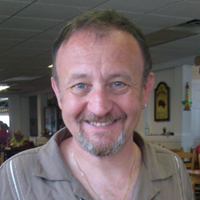
[email protected]
Professor of Physics & Astronomy, University of Tennessee, Knoxville
Research focus: Quantum Materials, e.g. synthesis, molecular quantum systems, 2D materials, quantum magnetism, strongly correlated electron systems, Quantum Control and Measurement, e.g. spectroscopy, out of equilibrium quantum measurement and sensing, transport, and devices.
Website: phys.utk.edu/people/faculty/mannella.html
Bio
Norman is a Professor in the Physics and Astronomy Department at UTK. Before joining UT in Fall 2007, he had a joint position in 2006 as Research Associate at Stanford University (Prof. Z. X. Shen’s group), and Beamline Scientist at the Advanced Light Source (ALS, Berkeley, CA) in the User Support System Group (Dr. Z. Hussain). After graduating with a PhD in 2003 from UC Davis (Prof. C. S. Fadley), Norman was a Postdoctoral Fellow at Stanford University (Prof. Z. X. Shen), with a joint appointment as a Visiting Scientist at the ALS in the User Support System Group.
Research Description
We work in the area of Experimental Condensed Matter Physics. Our group focuses on trying to understand how the macroscopic properties of complex materials originate from the microscopic interactions of electrons among themselves (electron correlations), and other degrees of freedoms such as lattice and spin. Our approach is based on spectroscopic techniques in the ultraviolet and soft x-ray regime available in our Laboratory at the Institute of Advanced Materials and Manufacturing (IAMM), or at Synchrotron Radiation Facilities. We most frequently use techniques such as angle-resolved photoemission spectroscopy (ARPES), core level photoemission spectroscopy (PES), x-ray absorption spectroscopy (XAS), and soft x-ray emission spectroscopy (XES). In collaboration with Prof. H. Weitering, our Lab. in IAMM features a unique facility where materials can be grown with Molecular Beam Epitaxy (MBE), and measured in-situ with ARPES and Scanning Tunneling Microscopy/Spectroscopy (STM/STS), two very powerful and complementary techniques for the study of Quantum Materials.
Recent research
Disentangling electronic, lattice, and spin dynamics in the chiral helimagnet Cr1/3NbS2 N. Sirica, H. Hedayat, D. Bugini, M. R. Koehler, L. Li, D. S. Parker, D. G. Mandrus, C. Dallera, E. Carpene, and N. Mannella Physical Review B 104, 174426 (2021) https://doi.org/10.1103/PhysRevB.104.174426
The Nature of Ferromagnetism in the Chiral Helimagnet Cr1/3NbS2 N. Sirica, P. Vilmercati, F. Bondino, I. Pis, S. Nappini, S. –K. Mo, A. V. Federov, P. K. Das, I. Vobornik, J. Fujii, L. Li, D. Sapkota, D. S. Parker, D. G. Mandrus, and N. Mannella Nature Communications Physics 3, 65 (2020) https://www.nature.com/articles/s42005-020-0333-3
Doping dependence of the magnitude of fluctuating spin moments in the normal state of the pnictide superconductor Sr(Fe1−xCox)2As2 inferred from photoemission spectroscopy Paolo Vilmercati, Yeongkwan Kim, Sung-Kwan Mo, Michael McGuire, Brian Sales, David Mandrus, Wei Ku, Luigi Sangaletti, David J. Singh, and Norman Mannella Physical Review B 99, 155132 (2019) https://doi.org/10.1103/PhysRevB.99.155132
Non-rigid band shift and non-monotonic electronic structure changes upon doping in the normal state of the pnictide high-temperature superconductor Ba(Fe1-xCox)2As2. Paolo Vilmercati, Sung-Kwan Mo, Alexei Fedorov, Michael McGuire, Athena Sefat, Brian Sales, David Mandrus, David J. Singh, Wei Ku, Steve Johnston, and Norman Mannella Physical Review B 94, 195147 (2016) https://doi.org/10.1103/PhysRevB.94.195147
Electronic structure of the chiral helimagnet and 3d-intercalated transition metal dichalcogenide Cr1/3NbS2 N. Sirica, S.-K. Mo, F. Bondino, I. Pis, S. Nappini, P. Vilmercati, J. Yi, Z. Gai, P. C. Snijders, P. K. Das, I. Vobornik, N. Ghimire, M. R. Koehler, L. Li, D. Sapkota, D. S. Parker, D. G. Mandrus, and N. Mannella Physical Review B 94, 075141 (2016) https://doi.org/10.1103/PhysRevB.94.075141
Research Image
